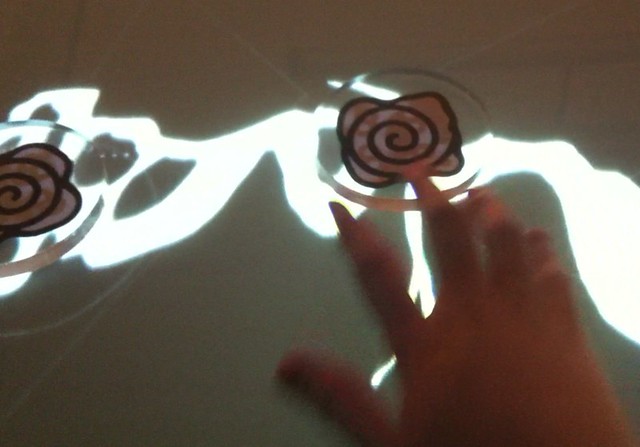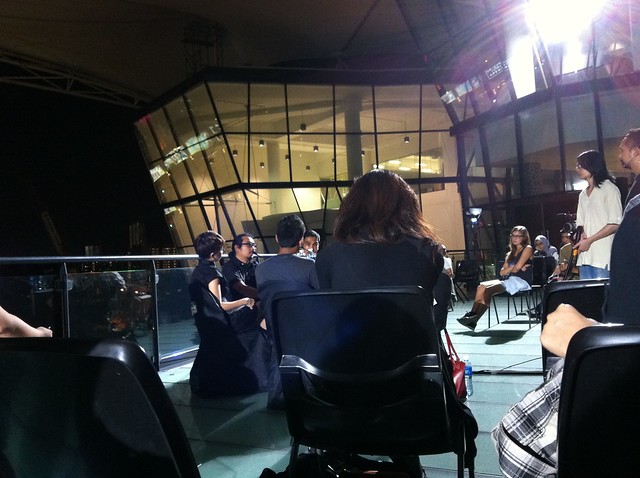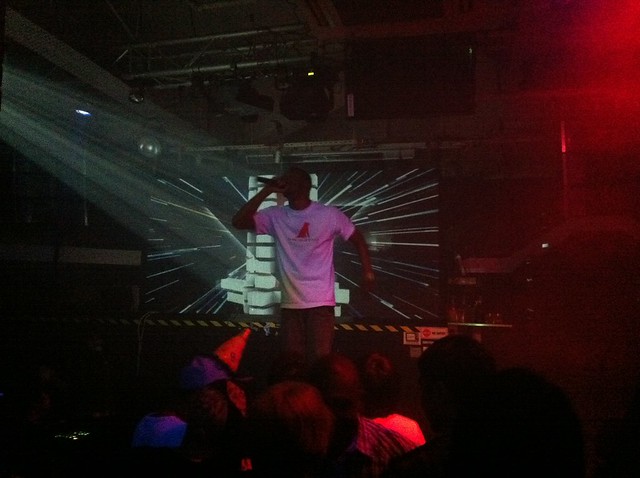Friday, November 19, 2010
CUBE, HAO, Community Museum Project, Really AR, Generi-City, Reclaimland and other digressions
Hello folks. This is the super-long update on recent going-ons: CUBE, HAO, Community Museum Project, Really AR, Generi-City, Reclaimland and other lovely digressions which I have encountered recently.
CUBEOpen
My work had been selected for the CUBE Open 2010 but sadly it was logistically impossible to bring my work to Manchester on such short notice. Nevertheless I am now working on a portable version of my reactable! From now onwards, where ever appropriate or feasible, portability shall be a consideration in all subsequent projects.

HAO
Last week I attended HAO, a four-day summit involving curators, art managers, and artists from Singapore and the region, organised by Audrey Wong and Khairuddin Hori and curated by Villains (well done you guys! it was one of the best things I have ever been to).



Amongst numerous other things (forgive me if I don't list every single thing down here), Mikal Telle shared with us his experience running Telle Records in Bergen and how he brought together musicians and artists (a rollercoaster story from bankruptcy to banksy! remarkable!), Margaret Chan regaled us with her research and insights on Tangki practice in the region (ritual, performance, and bicycle handles and other modern apparatus through the cheek?), Audrey Wong brought us to see her mother's Chinese Opera Teahouse on South Bridge Road (Cantonese Opera Karaoke!), and Zaki Razak also orchestrated/mediated a rather interesting dialogue-as-performance on the Lasalle Bridge (like a bridge over troubled waters?). Khairuddin Hori from SAM also took a gander at describing a "brief history of singapore contemporary art", which was pretty accurate and something which I think ought to be basic knowledge or incorporated into every single damn art school in Singapore. Everyone making art in Singapore should at least first understand the context in which art is created in Singapore even if they don't want to make work that fits into any particular tradition of the creation of art. I'm at the point where I think that the most sad thing for an artist is to make work which is completely universal and generic.
Community Museum Project
Which brings me to one of the things I saw there that completely blew me away. Howard Chen's presentation on his Community Museum Project - sheer genius. The "Street as Museum" and "Museum of Complaints" shares some commonalities with my own work, but Community Museum Project executes it so brilliantly and goes one step further by working closely with the communities and NGOs to effect changes/improvements after using their projects to uncover insights or hidden knowledge about the places.

From Community Museum Project: "Street as Museum".
Photo from Community Museum Project site.
This is constructive action, people! I want to be making works like that. Like what Raoul Vaneigem says, "people who talk about revolution and class struggle without referring explicitly to everyday life, without understanding what is subversive about love and what is positive in the refusal of constraints, such people have a corpse in their mouth." I think I would have more respect for people who go into "Opposition politics" in Singapore if they spent less time casting aspersions on PAP or inventing puerile nicknames for hot-button issues or newsmakers, and more time putting their money where their mouth is: finding out what is the real problem, and fixing these issues.
Everyone should go see the Community Museum Project site. Now.
Syndicate - DJ Nobody & Nocando (@ HOME Club)

Anyway, HAO was so perfectly organised that it coincided with Syndicate. So we all went down to where DJ Nobody & Nocando (L.A) played, a good one for the hardcore hiphop fans who turned up that night. Also saw Kiat, Max Lane and Darren Dubwise on the decks during the night, until ridiculous o'clock...
Circuitry, Crying Catz (@ Straits Records)

On the last night of HAO I also saw two acts play outside Straits Records - Circuitry and Crying Catz. Circuitry did an intense, punishing noise performance like the last time I saw them at Blackhole. As for Crying Catz, he makes this compellingly danceable combination of all the lovely ravey/dubby sounds. Todd-Edwards-cut-up-&-re-pitched vocals meets Zomby's-arcade-game-influenced jungle all mashed up with big wobbly bass. The metal screams make it even better! Strangely, I initially mis-remembered Crying Catz as Crazy Catz, which meant I unintentionally led me to many cat pictures and cat videos on the internet before I found the real Crying Catz. "Crying" makes more sense though, like that quote that i always remember from dj /rupture, of the "aestheticized cry" of auto-tune. But I digress...
Really AR
Last month I was invited by re:act to share my work at "Really AR 5". It ran alongside the opening of Generi-city, a photographic exhibition comparing "generic spaces" in Singapore and London. This was part of the ArchiFest 2010 fringe, and it featured photographs by Singaporean architects and architectural students/writers based in London. I forgot to write about it then, so here is a somewhat belated outpouring about that event. Johnny Gao & Pan Yichen spoke about the Generi-city project, Justin Zhuang shared with us his Reclaimland.sg project, and the eminent architect William Lim gave a talk about Singlish, proving his prowess as a nimble polymath (but maybe not so convincing as a Singlish speaker). For those who are unfamiliar with his work, he is responsible for well-loved buildings such as People's Park and Golden Mile, and he also worked on the conservation of Central Market (with the Annexe behind it) and its development into a cultural, shopping food and entertainment area.
Generi-city
The Generi-city project was "a series of conversations between six pairs of architects and architecture students", culminating in a series of images selected to fit broad categories such as "Transit, Eating, Leisure, Retail, Living and Occupational". A curious choice of categorization, I thought. Even with fairly good knowledge of both cities, sometimes I could not always immediately discern the usage of the space from just looking at the photograph.


Generi-city:
Photos of opening by Olivia Kwok
I find it incidental that this shot involves the two images which stood out the most for me. The small temple dwarfed by a new carpark is certainly one of the more compelling shots, especially when framed next to a picture of Shoreditch. I was excited to see a street that I recognised but hadn't visited in a long while, but the punctum for me in that shot was not what was in it, but what was not (ie: my not living in that city or walking down that exact street every single day anymore). If there is one road I remember in London, it has to be the path that a pedestrian has to take from Brick Lane to get to the bus stop on Shoreditch High St next to Tescos. This is of course, a memory that is special only to me.

But would the images have any meaning or impact on people who hadn't been to both cities before? How would one know the "use" of a space if one had not personally attempted to conduct any activities in that space before? For example, I am frequently confused about the boundaries of the proper prescribed "eating zone", like for example when I'm grabbing a small quick bite at one of those massive food halls in ION or Tangs after my Japanese classes. But couldn't anywhere be an "eating spot"? This would be simply a matter of taste, wouldn't it, in more ways than one; or would the act of eating in an unusual/unexpected place be viewed as a tasteless act by others? What about classifying spaces by number of people who depend on the building's existence, or the number of people interact with it, or how open/confined the space is?
I suppose their point was that the generic city is much more malleable - Singapore will custom-build its buildings to fit the needs of businesses; meaning that we can construct all sorts of big new spaces to specs and then stuff them full of things - whereas a place like London may have less room for maneuvering if it is to keep in the "spirit" of a grand old city; so people must retrofit old buildings or build conservatively in order to pander to urban planning approvals. A neat observation, but where then does it leads us from here? What does all this mean for the Generic (but actually flexible) city, and the Unique (but actually tidy) city? This seems to raise more questions than to provide any understanding on the issue; perhaps Johnny and team would like to explain more or expand more on this when they publish a more complete set of writing on this?
Reclaimland

Reclaimland.sg: Street barber Lee Yoon Tong
Photo by Sam Kang Li
Justin Zhuang also shared his work at Really Ar and I really loved the project he did with three other journalism students from NTU's Wee Kim Wee School of Communication and Information. They trace a number of cases in which people in the community have reclaimed land for their own usage in Singapore. From stories about community-built skateparks, citizen gardens under HBD flats, hidden kampung farms near the KTM rail tracks, to the old uncle who conducts his barber business behind the shophouses in Telok Ayer, they have been investigating these issues from a journalistic viewpoint, along with brilliant photo documentation. To read more, visit the Reclaimland site at http://reclaimland.sg. Justin also writes some really interesting stuff about design at his own site, http://justrambling.sg.
I think I have to stop now. How did this post get so ridiculously long...
Here is a list of all the links mentioned above. ENJOY!
Community Museum Project
Reclaimland.sg
Generi-city
reallyarchitecture

No Responses